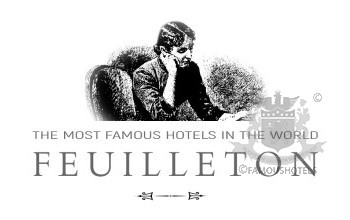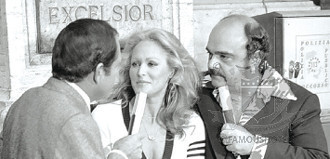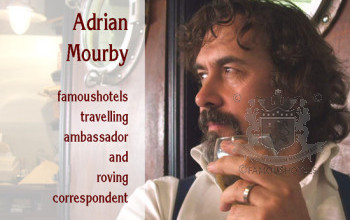Mourby of Rome — Eden
( words)

Our Roving Contributing Editor welcomes the reopening of Rome’s Hotel Eden.
When Cavalier Rufini took his census of Roman hotels for Pope Pius IX in 1855, the city was found to possess many small hotels and inns, some dating back to medieval times. There were several larger hotels too, including the imposing Hotel de la Minerve by the Church of Santa Maria Sopra Minerva, converted from a palazzo by a French hotelier, Joseph Sauve in 1810. It can still be found there today, albeit with an extra floor or two up top. Two other converted palazzi stood at the base of the Pincian Hill. What is now Hotel de Russie had been constructed 1816-1818 as Palazzo Lucernari by the great Giuseppe Valadier who designed most of Piazza del Popolo. When the British painter William Turner sketched Valadier’s work in progress in 1819, the palazzo had not yet been converted into L’Hotel des Isles Britannique as it was known in the census of 1855. By the end of the nineteenth century however Palazzo Lucernari had changed its name to the one we recognise today, Hotel de Russie. Meanwhile in 1845 Count Torlonia, the builder of Palazzo Lucernari had already converted a small sixteenth-century palazzo opposite his main palace on Via Bocca di Leone into an auberge for paying guests. What became known first as the Albergo d’Inghilterra was originally used to lodge the Torlonia’s visitors but, with tourism to Rome increasing during the long post-Napoleonic years of peace, it had seemed to the Count a very good idea to open it up commericially. In due course the Albergo d’Inghilterra became the building we know today, Hotel d’Inghilterra , flying the British, Italian and EU flags over its main entrance.
In the 1880s both Torlonia hotels were being managed by Francesco Nistelweck, a Munich-born hotelier. In Rome Nistelweck was assumed to be Swiss because in the nineteenth century it seemed all the great hoteliers were Swiss.
In October 1889 Francesco Nistelweck achieved his dream of converting a three-storey palazzo on the top of the Pincian Hill into a new 63-bedroom hotel of his own that he called The Eden. Herr Nistelweck’s wife, Berta Hassler was responsible for the furnishings. Berta was a daughter of the Swiss Hassler family who now run Hotel Hassler at the top of the Spanish Steps. In 1889 however her brother in law Heinrich Wirth was manager of the Hotel de la Minerve at the bottom of the hill. European hoteliery has always been an incestuous business.
The proximity of the the Pincian Hill to Porta del Popolo, the main entrance to the city for carriages arriving from the affluent north, made the location of the Eden ideal for attracting tourists
Like other ambitious hotel entrepreneurs of his time, Francesco Nistelweck installed all the new innovations that were proving so popular in hotels across New York, London and Paris: a lift, electric lighting, central heating and running water in all bedrooms.
The Eden quickly established itself and in 1902 a fifth floor was added to the building. On top of it was a broad terrace overlooking the entire city. At the beginning of the twentieth century the hotel used it to dry the Eden’s linen sheets and embroidered tablecloths. Many decades later it would become the Terrazza Restaurant, much loved of film director Federico Fellini who lived at the bottom of the Spanish Steps in Via Margutta in the 1960s and always insisted on being interviewed at La Terrazza.
Up until 1939 Hotel Eden received its share of the rich and the titled who seemed to be forever transitting between Europe’s grand hotels. The Livre d’Or records names like Princess Teresa of Bavaria, King Alfonso XIII of Spain, Prince Paolo of Serbia, Queen Amelia of Portugal and Grand Duchess Olga of Russia (proving that not all Russian aristocrats made their home at Hotel de Russie). One page has the signatures of several members of the prestigious Galitzin family from Russia alongside the actress Elenora Duse and her sometime lover the poet, pilot, politician and all-purpose Italian self-publicist, Gabriele D’Annunzio.
During World War II the signature of Franz von Papen, vice chancellor of the Third Reich and Hitler's ambassador to Turkey was added, as was that of Dino Grandi, Mussolini’s foreign minister. In 1941 Field Marshall Erwin Rommel added his name. In 1955 it was a source of great satisfaction to his North African rival, Field Marshall Bernard Montgomery to sign the book on the same page as a Desert Fox when he visited Hotel Eden.
The Eden ended the Second Worlrd War as the headquarters of the British military command. In due course it was subsequently passed back to Giuseppe and Gianfrancesco Ciaceri, grandsons of Francesco Nistelweck to run.
In 2013 Hotel Eden became part of the Dorchester Collection owned by the Sultan of Brunei and in 2015 it was closed for extensive renovations. Two years – and an undisclosed number of dollars - later it reopened this month (OR "in April 2017") .
The new Eden has expanded room size and suites, reducing its 121 bedrooms to 98 across six floors. Its Terrazza Restaurant still commands an impressive unbroken view as far as Altare della Patria, the giant white monument to Vittorio Emanuele II. It has now been joined by a less formal restaurant called Il Giardino which operates further around the terrace and overlooks the private entrance to the gardens of Villa Medici.
In all the hotel has preserved around 300 pieces of original furnishing or decoration –sideboards, tables, paintings and other works of art. A new Library bar created out of the far reaches of the old reception foyer displays an original fireplace. Mainly though the interior of the hotel is new, but with a timeless quasi-historical quality. There is a great deal of marble on display across the lobby floor, on walls and pillars throughout the hotel, in bathrooms and even in door jambs. It was sourced in Pakistan but skilfully reworked to dramatic effect by Italian masons.
The lead designer was Bruno Moinard whose watercolours of trees in the Medici gardens decorate most bedrooms. Wardrobes and headboards are lined with fabric. Gold mirrors, Murano chandeliers and cleverly aged glass give a sense of history but there are the usual concessions to modern technology. One’s whole room can be controlled – in theory - by an ipad and there are docking points for almost any device you might carry. The TV remote is a small, beautifully crafted and extremely heavy piece of metal - but just getting it to respond when the MENU button was pressed defeated this particular analogue guest.
Overall however the new Eden would probably please Francesco Nistlelweck should his spirit be hovering around the Church of Trinità dei Monti and looking down on this extensive refurbishment. Certainly the courtesy limousines that bypass Via Sistini and whip you straight to the top of the Spanish Steps are an act of stylish kindness. With its unbeatable views, friendly service and intoxicating smell of new carpets the return of Hotel Eden is just what Rome needed.











